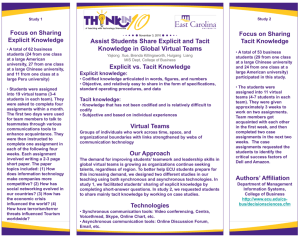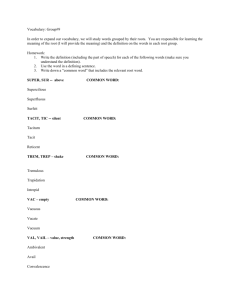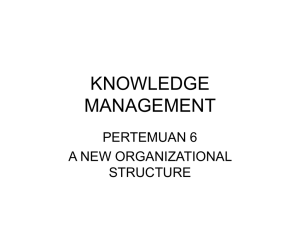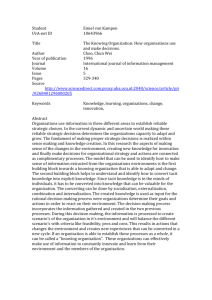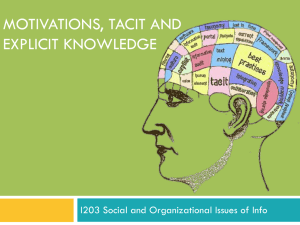InfoScience_KM_Spr10..
advertisement
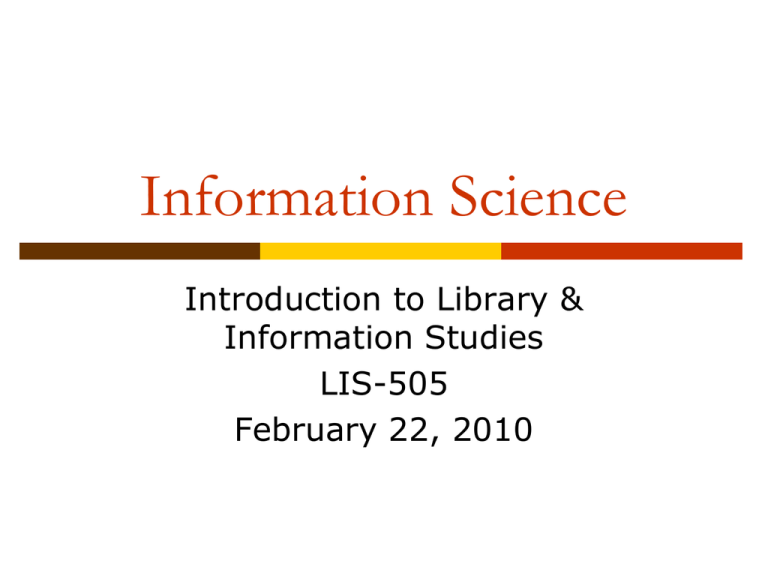
Information Science Introduction to Library & Information Studies LIS-505 February 22, 2010 Objectives To define information science To explore the relationship between information science and librarianship To review the arguments for and against information science as a discipline or profession 2 Information Science: Problems in Definition A matter of meaning – What is “information”? An ambiguous term Buckland (1991): information as process - act of informing; communication of something information as knowledge - the “something” which has been communicated information as thing - object such as data or documents 3 Buckland (1991): Information-asThing – Representation Information systems (e.g. IR and ‘expert’) can only deal with information directly as information-as-thing (i.e. physical representations of knowledge) Representations of knowledge and of events are information-as-thing Concept of evidence — passive — humans do things with it or to it (e.g. interpret it, describe it, etc.) 4 Representations: Buckland (1991) “If an object is not representative of something, then it is not clear how far it can signify anything, i.e., be informative” (p.355). 5 I.S. Representations: Characteristics (Buckland, 1991) Somewhat incomplete—something of original is lost. Made for convenience (e.g. easier to store, search, understand) Shift from event or object to text; text to text; object and texts to data Additional details may be added to the representation to inform or misinform Process of representation can continue indefinitely Usually briefer or smaller than whatever is being represented. 6 And what do we mean by “science”? At pure science level purpose is to find out truth(s) of the matter studied. 7 Information Science: Bates (1999) Information science studies the world of recorded information produced by human agency (‘fourth universe’). How humans produce, seek, retrieve and use this universe = intellectual domain of information science. 8 The Content of Form: Bates (1999) Applied IS focuses on form, organization and structure of information not with content. IS is a meta-discipline; Information is the “red thread” that runs through it. “The average person, whether Ph.D. scholar or high school graduate, never notices the structure that organizes their information, because they are so caught up in absorbing and relating to the content” (p. 1045). 9 The Content of Form: Bates (1999) “…at first it feels alien to think about a resource in terms of the features that matter to the organization and retrieval of it, rather than in terms of mastering its content” (p. 1046). Underlines need for information expertise not subject expertise. 10 Characteristics of Information Science: Bates (1999) Interdisciplinary. Closely linked to IT. Possessing a social and human dimension. Service and empowerment-oriented value system. 11 Information Science: Griffiths (2000) “Information science focuses on the relationship between people and recorded knowledge and uses a variety of tools to help understand and improve the relationship.” (p. 25) People. By developing deeper understandings of people’s preferences and practices, helps in the design and delivery of improved processes and services for production, dissemination, receipt and use of recorded information. 12 Information Science: Griffiths (2000) Recorded Knowledge. Better understanding of the structure of knowledge, format and medium used to communicate information content helps in the process of organization, dissemination and communication. Tools. Research into tools design, development and evaluation can improve relationship between people and recorded knowledge in its creation, capture, storage, preservation, identification, dissemination and use. 13 IS: Field of practice and scientific inquiry Study of information to generate theoretical models (More on this next week!) Development and implementation of models to enable the design of better information systems Profession of providing an information service (Saracevic) 14 Do definitions matter? “Debates over the ‘proper’ definitions of information science, as of any field, are fruitless, and in expectations naïve. Information Science, as a science and as a profession, is defined by the problems it has addressed and the methods it has used for their solutions over time” (Saracevic, 1999 p. 1051). 15 Information Science : A More Recent Definition The systematic study and analysis of the sources, development, collections, organization, dissemination, evaluation, use, and management of information in all its forms, including the channels (formal and informal) and technology used in its communication. Reitz, Joan. (2004). Dictionary for Library and Information Science. Westport, CT: Libraries Unlimited. p. 358. 16 The 3 Big IS Questions What are the features and laws of the recorded information universe? How do people seek and use information? How can access to recorded information be made most rapid and effective? (Bates) 17 Information Science: Content Information use and users Information organization Information systems Human-computer interaction (HCI) Information retrieval (IR) Evaluation Information services Information dissemination Bibliometrics 18 Information Science: Content Saracevic: Two clusters of study in Information Science (as shown by a bibliometric analysis, 1998) One cluster: Information analysis This includes: Content analysis of texts, communication, information uses, information behavior Second cluster: Retrieval This includes: User studies of IT, library systems, OPACS, IR theory, retrieval algorithms, HCI 19 Information Science: Supporters of I.S. distinct from Library Science IS cannot be equated with documentation, information retrieval, librarianship or with anything else. Information science is not souped up IR or librarianship any more than physics is supercharged engineering. (Rees & Saracevic) Librarianship and documentation are applied aspects of information science; techniques and procedures used by librarians and documentalists are, or should be, based upon the theoretical findings of information science. (Borko). 20 Information Science: Opponents It is quite evident that information science is rooted in attempts to extend the boundaries of library technology and give it revived respectability by endowing it with a unique name (Shera). Efforts to tease apart the disciplinary domains of library science and information science have been unsuccessful; they have arisen more from discontent with the status quo than from adequate cognitive claims, usually by non-librarians discontented with librarianship (Schrader). 21 Information Science: Compromisers Library and information science represent “a disciplinary continuum …with no easily identifiable boundary separating them, though the difference between the extreme ends of the continuum are clear and even dramatic” (Rayward) Librarianship and practical information science both have in common an information perspective, even though they have very different histories (Bates) 22 What’s in a Name? Names Names Names Names of of of of Programs Departments Journals Associations Convergence or Divergence? 23 New names for old ideas? Information studies Information systems Information management Knowledge management The debate continues………………. 24 15 MINUTES 25 Knowledge Management Introduction to Library & Information Studies LIS-505 Adapted from a presentation by Dr. K. Dalkir, School of Information Studies McGill University, Montreal, Quebec General Introduction to KM KM is a relatively new discipline that has emerged from business practitioners to form a new discipline of study KM is extremely multidisciplinary in nature KM is full of people from highly diverse backgrounds KM is a “work in progress” – it has not yet matured into a well defined profession such as engineering, medicine and law 27 A brief history of KM YEAR ENTITY EVENT 1986 Dr. K Wiig Coined KM concept at UN 1989 Consulting Firms Start internal KM projects 1991 HBR article Nonaka & Takeuchi 1993 Dr. K Wiig First KM book published 1994 KM Network First KM Conference 1997 Consulting Firms First KM services for clients 28 Why do we need KM? It was easy to do in the past - - “coffee cliques”, smoker’s gathering, water coolers…. Traditionally, we have shared knowledge through ‘word of mouth’ (e.g. master to apprentice) socializing comes ‘naturally’ to us, there are fewer opportunities in today’s much larger, much more global companies 29 Today’s Working Environment Multi-lingual Multi-site Multi-cultural More & Faster More Global KM More Mobile More Connected 30 Increasing Complexity Today’s work environment is more complex due to an increase in the number of subjective knowledge items we need to attend to everyday Filtering over 200 emails, faxes, voicemail messages on a daily basis – how to prioritize? Having to “think on our feet” as expected response time has greatly decreased as well KM is a response to the challenge of trying to manage this complexity amidst information overload A “science of complexity” 31 Thanks to Felicity Tayler for the figure What is KM? A definition: Knowledge management (KM): The systematic capture, organization, leveraging and dissemination of an organization’s knowledge (tacit and explicit) to improve the efficiency and adaptivity of teams and to promote innovation 33 More definitions… • KM is the systematic, explicit and deliberate building, renewal and application of knowledge to maximize an enterprise’s knowledge-related effectiveness and returns from knowledge assets (K. Wiig) • KM is the process of capturing a company’s collective expertise wherever it resides: in databases, on paper, in people’s heads – and distributing it to wherever it can help produce the biggest payoff. (Hibbard) • KM is getting the right knowledge to the right people at the right time so they can make the best decision (Petrash) 34 Even more KM Definitions… It is the attempt to recognize what is essentially a human asset buried in the minds of individuals, and leverage it into an organizational asset that can be accessed and used by a broader set of individuals on whose decisions the firm depends (Prusak) KM applies systematic approaches to find, understand and use knowledge to create value (O’Dell) KM is the explicit control and management of knowledge within an organization aimed at achieving the company’s objectives (van der Spek) KM is the formalization of and access to experience, knowledge, and expertise that create new capabilities, enable superior performance, encourage innovation and enhance customer value (Beckman) 35 KM addresses two different forms of knowledge: Tacit Knowledge Explicit Knowledge files 80-85% active 15-20% passive 36 37 Tacit Knowledge Difficult to articulate – to put into words, text, drawings “We have a habit of writing articles published in scientific journals to make the work as finished as possible, to cover up all the tracks, to not worry about the blind alleys or how you had the wrong idea at first, and so on. So there isn’t any place to publish, in a dignified manner, what you actually did in order to do the work.” (Richard Feynman) “We know more than we can tell” (Michael Polanyi) 38 The Nonaka-Takeuchi Model of Knowledge Management “In an economy where the only certainty is uncertainty, the one sure source of lasting competitive advantage is knowledge.” I. Nonaka The authors studied successful Japanese companies to understand how they achieved creativity and innovation Metaphors, slogans, symbols and serendipity 39 KM occurs at 3 levels: Individual Group/team “community of practice” Organization 40 Four Knowledge Transformations Tacit Explicit Tacit Explicit LIS-505 February 21, 2009 41 Knowledge sharing Tacit Tacit Explicit Socialisation Brainstorming Team work Mentorship Internalisation: Comprehension Learning Explicit Externalisation Capture Make tangible Combination: Organisation Classification 42 The KM Cycle Tacit Tacit Explicit Explicit Create and Share Capture and Codify Acquire and Apply Classify and Organize 43 KM has already gone through 3 generations: 1st Generation: IT 2nd Generation: “if we only knew what we know” “if we only knew who knows about….” PEOPLE 3rd Generation: “if we could only organize our knowledge….” CONTENT 44 ICM vs Knowledge Management* Knowledge Management Intellectual Capital Management •Lots of content – archiving •Documents - warehousing •Search engines needed •$$$ needed •Frustrating to find anything •Minimum content – only that of value •People’s real thinking - stories •Sharing and reuse of best practices •Actionable knowledge & know-how •Less $$$ needed *1st and 2nd generation KM 45 Intellectual Capital Management MANAGE CONTENT MANAGE TALENT MANAGE CONNECTIONS 46 KM Link to Information Professionals Knowledge Organization Traditionally, Library and Information Science has focused on the organization of explicit knowledge Books, documents This scope needs to be enlarged to include tacit knowledge – all intellectual assets at 3 levels: Individual Group (“community of practice”) Organization (corporate/organizational memory) Analogy: statisticians and data mining …………librarians and knowledge management 47

